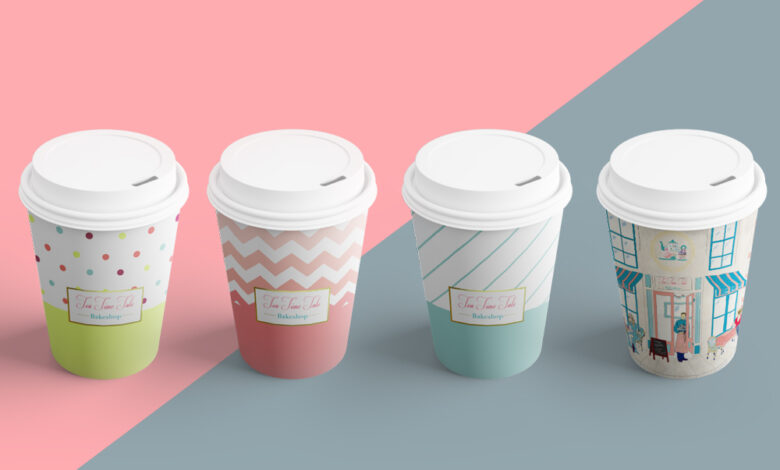Artisan Techniques for Unique Cup Printing

Cup printing has evolved from simple branding to a full art form. Today, artisan techniques bring creativity and uniqueness to every cup design. These traditional and handcrafted methods add personality, texture, and story to what would otherwise be just another disposable item.
Hand-Painted Cup Designs
One of the most authentic ways to create unique cup prints is hand-painting. This method involves skilled artisans who paint each cup individually. They use brushes, stencils, and sponges to apply designs directly onto the surface. This approach gives each cup a one-of-a-kind look, as no two painted cups are exactly the same.
The beauty of hand-painted cups lies in the imperfections. Slight variations in color, line thickness, and patterns give these cups a human touch. Artists can create abstract art, floral designs, or even miniature portraits. The only limit is the imagination of the painter. This technique is time-consuming but adds great value to the product.
Hand-painting also allows for customization. Customers can request names, logos, or specific designs that reflect their personal taste or brand identity. This flexibility makes it ideal for special events like weddings, birthdays, or corporate promotions.
In addition to aesthetic appeal, hand-painted cups are often made with safe, lead-free paint. They are baked in kilns to ensure the artwork lasts longer and does not wash off easily. While they may not be suited for mass production, they are perfect for limited editions and artisan marketplaces.
Combining Techniques for Signature Styles
Many artisans create signature cup designs by combining two or more printing methods. For example, a hand-painted base can be topped with block-printed patterns. Or a wax resist design can be enhanced with natural stamping.
This approach allows for greater creativity and personal expression. It also helps artists stand out in a crowded market. When done skillfully, the mix of textures, colors, and effects tells a deeper story.
Combining techniques also allows artisans to highlight the best features of each method. For example, the precision of screen printing can balance the softness of brush strokes. Or the tactile quality of embossing can elevate a minimalistic decal design.
To support this level of creativity, many artisans look for eco-conscious suppliers. One such provider is https://ibexpackaging.com/custom-cups/, known for its wide variety of customizable and sustainable cup options. These help artisans bring their visions to life while staying true to their environmental values.
Block Printing for Cups
Block printing is an old printing technique that still holds relevance in modern artisan cup making. It involves carving a design into a block made of wood, rubber, or linoleum. This block is dipped in ink and pressed onto the cup to create a repeatable pattern.
The handmade block acts like a stamp. Artisans press it against the cup’s surface with even pressure, transferring the inked design. Though the process may seem simple, it takes skill to align the block correctly and apply just the right amount of ink.
One major advantage of block printing is consistency in repeated patterns. You can print floral borders, geometric shapes, or tribal designs around the cup. This method is popular among small businesses that value sustainability and slow production over mass output.
Block-printed cups often carry earthy tones and organic textures. They appeal to customers who appreciate craft and tradition. This technique also allows for creative combinations of colors and blocks, resulting in layered and textured designs.
To protect the printed design, artisans usually seal the ink with a food-safe varnish. This helps prevent fading or smearing when the cup is used. Though the printing is surface-level, the charm of block printing lies in its tactile and visual depth.
Screen Printing on Ceramic Cups
Screen printing, also known as silk screening, is a popular artisan method for decorating ceramic cups. It involves creating a stencil on a mesh screen and pushing ink through the open areas onto the cup’s surface. This technique allows for clean lines and sharp designs.
What makes screen printing special is the control it offers over details. Even intricate artwork and fine text can be clearly printed. It’s a perfect method for small batches of branded cups, art editions, or local café merchandise. The screens can be reused, making it cost-effective for artisan-scale production.
The process starts with a design printed on transparent film. This film is placed on a screen coated with light-sensitive emulsion. When exposed to light, the emulsion hardens except where the design blocks it. The unexposed parts are then washed away, leaving a stencil.
Once ready, ink is applied on the screen and pressed through with a squeegee. The ink only passes through the open stencil parts onto the cup. After printing, the cup is dried and heat-cured to make the design permanent.
Screen printing allows for layering of colors and is ideal for logos, slogans, and stylized graphics. Artisans often use water-based inks, which are eco-friendly and safe for food contact. The final product looks professional but still retains a handcrafted feel.
Decal Transfer Technique
Decal transfer is another artisan-friendly printing method that involves applying pre-printed designs to cups. The design is first printed on special paper using ceramic inks. Then, the decal is soaked in water and slid onto the surface of the cup.
This method is ideal for complex artwork, like portraits, calligraphy, or logos with many colors. Because the image is printed separately, it gives the artist full control over the design before application. This reduces errors and waste.
Once the decal is placed, it needs to be smoothed out carefully. Air bubbles or wrinkles must be removed using soft brushes or rubber tools. After drying, the cup goes into a kiln where the decal fuses with the ceramic glaze.
This process creates a design that is long-lasting, glossy, and resistant to washing. It is perfect for limited-edition cups or custom promotional items. Small cafés and artists often use this method to create branded merchandise or collectable series.
Unlike hand-painting or block printing, decal transfer allows for photo-quality detail. However, it still requires hand skill for proper placement and firing. The technique balances modern design with artisan control.
Embossing and Debossing Techniques
Embossing and debossing are tactile printing methods that create raised or recessed designs on a cup’s surface. These techniques require molds or stamps to press the design into the material. Though more commonly used on paper or leather, they’re gaining popularity in ceramic and biodegradable cup printing.
In embossing, the design is raised above the surface. Debossing pushes it inward. Both create a 3D texture that feels good to the touch. These effects work well with minimalist designs, such as initials, brand marks, or symbols.
The artisan process involves heating the cup slightly and pressing it against a mold. Some cups require pre-softening or moisture to make the surface more pliable. The pressure then forms the design permanently.
Because these methods don’t use ink, they’re eco-friendly and elegant. They’re especially popular with high-end brands and artisanal coffee shops. A simple embossed logo on a kraft paper cup can create a strong brand identity without extra color or graphics.
These methods also offer excellent compatibility with recyclable or compostable materials. In a world moving towards sustainability, embossing and debossing present a smart choice for artisans.
Stamping Techniques Using Natural Materials
Artisans often turn to nature for inspiration and materials. One such method is using leaves, bark, fruits, or other natural items as stamps. These objects are dipped in dye or ink and pressed onto the cup to leave unique, organic impressions.
This technique captures the veins of a leaf or the texture of tree bark in beautiful detail. Because natural items vary in size and shape, no two prints are ever the same. This adds a raw, earthy appeal to the finished product.
To prepare, artisans clean and dry the materials. They apply natural dyes or water-based inks to avoid chemical contamination. The stamping process requires a careful hand to press evenly and avoid smudging. Some artists also use natural wax to seal the design for protection.
Stamped cups made with natural materials are popular in eco-conscious markets. They reflect both environmental care and artistic vision. For small businesses, this method offers a low-cost, low-impact way to personalize their packaging.
Using Wax Resist for Artistic Patterns
The wax resist technique is a clever way to create contrasting designs on cups. It involves applying wax to areas of the cup that should not receive color. When the cup is dipped in dye or glaze, the waxed parts stay untouched, revealing a beautiful pattern after the wax is removed.
This technique has been used for centuries in pottery and textiles. In cup printing, it adds artistic flair and a handmade touch. Artists use brushes, sticks, or even fingers to apply the wax in creative ways. Swirls, dots, and lines are popular choices.
After waxing, the cup is dipped in a colored glaze or dye. Once it dries, the wax is melted or scraped off, leaving the original color underneath. The contrast between the dyed and untouched areas creates striking effects.
Wax resist designs often look spontaneous and organic. They are great for small runs and artistic collections. The process is safe and environmentally friendly when using natural wax and non-toxic dyes.
Conclusion
Artisan techniques in cup printing bring unmatched charm, creativity, and individuality to each piece. Unlike mass production, these methods reflect the care, passion, and skill of the artist behind the design. Whether it’s through hand-painting, block printing, embossing, or natural stamping, each technique adds its own unique value and aesthetic.
These handcrafted methods not only create beautiful and functional products but also promote sustainability, cultural heritage, and personal expression. They offer an excellent choice for businesses, artists, and consumers who value originality and craftsmanship.



